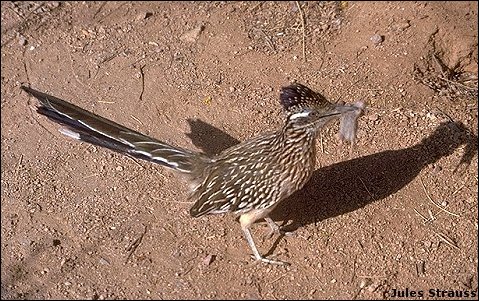

How fast can you run? Ten miles an hour? How about 15? We've all seen animals that can outrun a person, but why on earth is there a bird, perfectly capable of flying, who prefers to run—and can outrun any of us?! If you're lucky, you may have seen our amazing roadrunners in your yard or racing down the highway. These birds have been clocked as fast as 26 miles an hour, but their talents hardly end there.
Although it eats such things as lizards, small mammals, and insects, the roadrunner is most famous for its ability to make a meal of venomous snakes. Then its speed becomes essential, as it darts in and out, pecking a hapless snake to death.
The roadrunner's impressive talents were not missed on Native Americans. To the Zuñi, they were keepers of courage and knowledge. At Cochiti Pueblo, copies of the roadrunner's "X"-shaped tracks were placed around the dead to ward off evil spirits. The Hopi even used roadrunner feathers, attached to their horses' tails, to impart swiftness and stamina to their steeds.

Listen to the Audio (mp3 format) as recorded by KTEP, Public Radio for the Southwest.
Contributor: Scott M. Cutler, Centennial Museum, University of Texas at El Paso.
Desert Diary is a joint production of the Centennial Museum and KTEP National Public Radio, University of Texas at El Paso.

Greater Roadrunner (Geococcyx californianus) with prey. Photograph by Jules Strauss. © California Academy of Sciences.
Ligon, J. S. 1961. New Mexico Birds and Where to Find Them. University of New Mexico Press, Albuquerque, 360 pp.